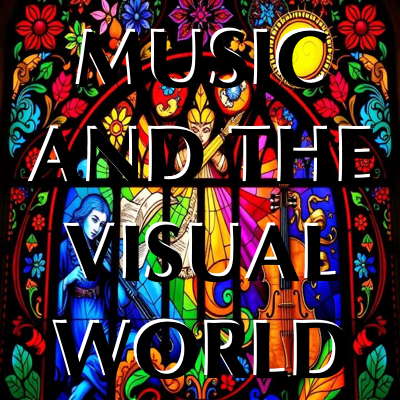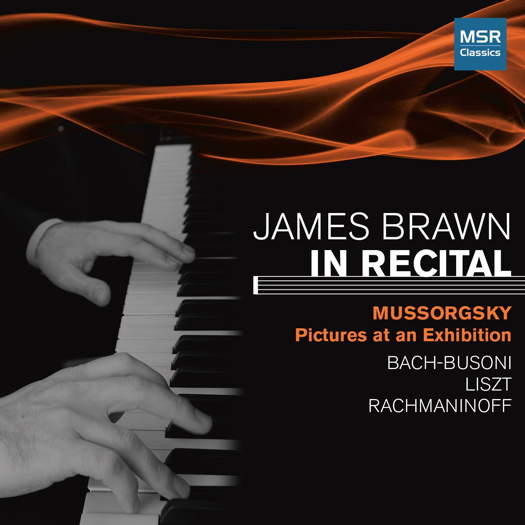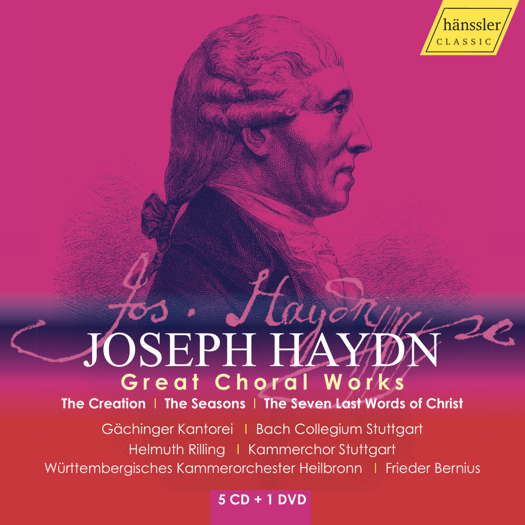- Bolero
- Robert Hugill
- BBC Philharmonic Orchestra
- Macau
- Massenet
- Donald Runnicles
- Simon Broughton
- Korngold: 4 Lieder nach Shakespeare
 DISCUSSION: John Dante Prevedini leads a discussion about Music and the Visual World, including contributions from Celia Craig, Halida Dinova and Yekaterina Lebedeva.
DISCUSSION: John Dante Prevedini leads a discussion about Music and the Visual World, including contributions from Celia Craig, Halida Dinova and Yekaterina Lebedeva.
 SPONSORED: CD Spotlight. True Command - James Brawn plays Bach, Liszt, Musorgsky and Rachmaninov - recommended by Andrew Schartmann.
SPONSORED: CD Spotlight. True Command - James Brawn plays Bach, Liszt, Musorgsky and Rachmaninov - recommended by Andrew Schartmann.
All sponsored features >>

A Transcendental Experience
Choral music by Franz Joseph Haydn, unreservedly recommended by GERALD FENECH
'... these interpretations overflow with humanity, humility, sincerity and, above all, a heartfelt spontaneity ...'
When Franz Joseph Haydn (1732-1809) was invited to visit England by the impresario and violinist Johann Peter Salomon, he was the greatest and most popular living composer of the age. Indeed, Haydn made two extensive concert tours in 1791-92 and 1794-95 respectively, and while there he was lucky enough to hear some of Handel's grand choruses written for The Messiah and Israel in Egypt.
At the end of his second stay, Haydn brought back with him an English libretto, written by an anonymous author, that dealt with the narrative of the 'Creation'. This libretto was based on the Book of Genesis, the Psalms and Milton's Paradise Lost. Haydn wanted this text translated into German so that he could write the music, and this job was handed to his friend Baron Gottfried von Swieten, who fashioned an excellent translation in a short space of time.
Inspired by the Handel choruses and the absolute beauty of the story, the composer set to work in earnest, but progress was slow and The Creation took nearly two years to be completed. The oratorio is in three parts and opens with an orchestral prelude called 'The Representation of Chaos', where stark chords and shifting harmonies portray the formlessness and disorder that preceded the 'Creation'.
Listen — Haydn: Einleitung - Die Vorstellung des Chaos (The Creation)
(HC21054 CD1 track 1, 0:00-0:55) ℗ 2021 Profil Medien GmbH / Hänssler Classic :
The remainder of the first and all the whole of the second part cover the remaining six days of the narrative, with each day introduced in recitative by the Archangels Raphael, Uriel and Gabriel. Each new creation – light, water, landscape, plants and beasts of land, sea and air - is depicted with lavish tone-painting.
The third part is the story of Adam and Eve, and focuses on the happy union between the two, culminating in a tender marriage duet, while both marvel at the incomparable beauty of God's work.
Listen — Haydn: Holde Gattin! Dir zur Seite (The Creation)
(HC21054 CD2 track 13, 7:11-8:03) ℗ 2021 Profil Medien GmbH / Hänssler Classic :
The oratorio was first heard in a public rehearsal at the Schwarzenberg Palace, Vienna, on 29 April 1798. On the following day it was performed again, this time in the form of a private affair for a selected audience. The first public presentation of the piece took place on 19 March 1799, at the old Burgtheatre in Vienna, and it was a sensation. Everyone was simply hypnotized by this profoundly spiritual and uplifting music, and many went home still under the spell of this transcendental experience.
A Viennese journalist, Joseph Richter, wrote: 'I wouldn't have believed that mere human lungs and sheep gut and calf's skin could create such miracles. I never left a theatre more contented, and all night I dreamed of the Creation.' Another eyewitness, Johann Berwald (cousin of Swedish composer Franz), reported that the whole performance went off wonderfully. 'Between the sections of the work, tumultuous applause; during each section, however, it was still as a grave.'
When it was over, there were calls of, 'Father Haydn to the front'. Finally, the old man came forward and was greeted with tumultuous applause and with cries 'Long live Father Haydn, long live music.' Truly a work for the ages.
Now for The Seasons. Haydn was led to write this secular oratorio by the great success of his previous work in the genre, The Creation, which had become very popular and was in the course of being performed all over Europe. The libretto for The Seasons, as for The Creation, was written by Baron von Swieten, who based his work on extracts from the long English poem The Seasons by James Thomas, which had been published in 1730. Like The Creation, The Seasons was intended as a bilingual work and von Swieten obliged accordingly, in spite of his English leaving a lot to be desired. The composition process was arduous for Haydn, in particular because his health was gradually fading and partly because the composer found the libretto to be somewhat taxing. Haydn took two years to complete this work.
Like The Creation, The Seasons had a dual premiere, first for the aristocracy at the Schwarzenberg Palace in Vienna on 24 April 1801, then for the public at the Redoutensaal on the nineteenth of the following month. The oratorio was a clear success, but nothing to compare with The Creation. In the years that followed, Haydn continued to lead oratorio performances for charitable causes, but it was usually The Creation that he took charge of.
The oratorio The Seasons is divided into four parts corresponding to the four seasons, with the usual recitatives, arias, choruses and ensemble numbers. Among the more rousing choruses are a hunting song with horn calls, a wine celebration with dancing peasants, a loud thunderstorm and a rather absurdly stirring ode to toil.
Some beautiful lyrical passages are the choral prayer for a bountiful harvest ('Be thou gracious, O kind heaven') and Hanne's cavatina on Winter. The work is filled with tone painting: a ploughman whistles as he works, a bird shot by a hunter falls from the sky, a sunrise and a host of other musical snapshots that describe every situation imaginable connected with rural life during Haydn's day. Maybe The Seasons will never attain the popularity of The Creation, but there is no denying the absolute sublimity of the music, and the way Haydn fuses the ever changing beauty of nature with man's integration into its evolvement is quite absorbing.
On a personal note, I find The Seasons a continuation of The Creation, where one cannot live without the other. Indeed, 'The Seasons' are the perpetual flourishing of 'The Creation', where man and nature are part of an incomprehensible mystery that time cannot erase. The final ecstatic 'Amen' says it all.
Listen — Haydn: Dann bricht der große Morgen an (The Seasons)
(HC21054 CD4 track 24, 4:21-5:19) ℗ 2021 Profil Medien GmbH / Hänssler Classic :
The Seven Last Words of Our Saviour on the Cross started life as an orchestral work. Commissioned in 1786 for the Good Friday Service at the Holy Cave Oratory in Cadiz, Spain, the work quickly spread to several European capitals after its publication in 1787. Again, in 1787, Haydn adopted a version for string quartet, and in the same year approved a version for solo piano. Finally, in 1796, the composer adapted the piece as an oratorio for solo and choral vocal forces. The seven main meditative sections are based on the seven last utterances of Christ during his crucifixion. The sections are labelled 'sonatas' and are all slow. They are framed by an 'adagio' introduction and a turbulent 'Earthquake' conclusion for a total of nine movements.
Listen — Haydn: Il Terremoto (The Seven Last Words of Christ)
(HC21054 CD5 track 10, 1:25-2:10) ℗ 2021 Profil Medien GmbH / Hänssler Classic :
Haydn himself explained the origin and difficulty of composing the work when publisher Breitkopf and Härtel issued a new edition in 1801 and requested a preface. '... it was no easy task to compose seven adagios lasting ten minutes each, and to succeed one another without fatiguing the listeners; indeed, I found it quite impossible to confine myself to such limits.'
Of the three versions Haydn wrote, it is the choral one we are concerned with here. While on his second journey to London (1794-1795) he passed through Passau. There, Haydn heard a revised version, amplified to include a chorus. The words were by the local Kapellmeister Joseph Friebert, and were not original Latin but pietist poetry written in German. Haydn was impressed and decided to improve on it, preparing his own choral version. In this regard he sought the assistance of Baron von Swieten, a collaboration that was to continue for the next two oratorios, both included in this review. This choral version was privately premiered in Vienna on 26 March 1796, before an audience of the nobility. The public premiere was on 1 April 1798, sponsored by the Torkunstler-Societat, a Viennese benefit society for musicians.
The music is intense, moving, contemplative and often anguished. Indeed, Haydn was not only a tone-painter of nature but more of a painter of the soul, where the most intimate of feelings are in a constant struggle between good and evil. What happened on Calvary on that first Good Friday cannot be comprehended by the human mind, because it is a mystery of unfathomable significance and beyond reason. One can only accept it through faith, and Haydn had lots of this, which is why he surpassed himself in this most ethereal of works, despite its being commissioned. Indeed, his reverential devotion and infinite gratitude for the crucified Christ pour out of every note. Listening to the Seven Last Words of Christ on the Cross is an experience of the most profound awe that is bound to leave a mark on each person that hears this music, be he a believer or not.
The programme is completed by two small sacred compositions, of which Haydn wrote many: the 4 Responsoria de Venerabili, XXIII c No 4, and Ave Regina Coelorum in A, XXIII b No 3, serene pieces that contrast perfectly with the three major works.
Recorded between 1981 and 1993, when Helmut Rilling was at the height of his powers, these interpretations overflow with humanity, humility, sincerity and, above all, a heartfelt spontaneity that penetrates to the very core of these spiritually edifying masterpieces. The Stuttgart forces respond with compelling performances that capture all the spiritual gravitas of these works. The singing, in particular, is permeated by an all round nobility that befits these glowing and dramatic scores. The two short choral pieces earmarked above are beautifully sung and conducted by Frieder Bernius and his team, making a perfect ending to the whole enterprise.
There is also a DVD version of The Seasons for good measure. An album for all seasons from a composer for all seasons. Unreservedly recommended.
Copyright © 12 July 2022
Gerald Fenech,
Gzira, Malta

CD INFORMATION - JOSEPH HAYDN: GREAT CHORAL WORKS


